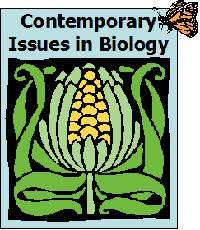
Week 9, Chapter 5 -- Freelance Writer Sample Answer
Course home | Weekly schedule | Announcements | Instructor Info | Desire2Learn | MasteringBiology® | Honor Code | FAQs | HELP!
 |
Week 9, Chapter 5 -- Freelance Writer Sample AnswerCourse home | Weekly schedule | Announcements | Instructor Info | Desire2Learn | MasteringBiology® | Honor Code | FAQs | HELP! |
BEN: Good evening, everyone. I'm Ben Wanderin reporting to you from The Retinoblastoma Center Children's Hospital in Los Angeles. With me are Dr. Linn Murphee and 3-year old Emily Jones. Emily is here because she is suspected to have a rare form of eye cancer known as retinoblastoma. This cancer affects the retina, or the light sensitive cells in the back of the eye. We're here on the scene to help with Emily's diagnosis as Dr. Murphee and I will be reduced to molecular size and enter Emily's eye to see what we can find!
BEN: Dr. Murphee, just by looking at Emily's eye, do you have any suspicions as to her condition?
DR. MURPHEE: Well, Ben, just by looking at the surface of her eye, you can see that it appears to be red. When you shine a light into her pupil you would typically expect the pupil to reflect red, but in Emily's case it appears white. These are pretty common indicators of retinoblastoma along with Emily's age. This is one of the few types of cancer that typically occurs in children younger than 5 years old. After our voyage into Emily's eye, we'll follow up with some more typical diagnostics such as MRI or ultrasound.
BEN: Dr. Murphee, are you ready to enter Emily's eye?
[Dr. Murphee and Ben are reduced to molecular size, placed in an eye drop solution, and dropped into Emily's right eye. After cautiously climbing into Emily's eye through her pupil they are amazed at what they find. Dr. Murphee and Ben stand staring at a giant mass on Emily's retina.]
BEN: Whoa! What is that?
DR. MURPHEE: That's just what I expected to see here, Ben. That is a tumor. It's a mass of tissue that has accumulated in the back of Emily's eye due to unregulated cell division.
BEN: What on earth would cause unregulated cell division in someone as young as Emily?
DR. MURPHEE: Retinoblastoma can be inherited from your parents, although since Emily's problem is limited to just her one eye, I suspect that her cancer was not inherited. In Emily's case, a mutation, or alteration in the normal sequence of her DNA, probably occurred. This mutation likely affected how cell division is regulated in Emily's retina. Over time, unregulated mitosis can lead to the accumulation of cells, or tumors.
BEN: Dr. Murphee, it's easy for us to diagnose Emily's condition by shrinking down and crawling into her eye, but how do you plan to remove the tumor? It would take a whole surgical team to climb in here and remove that!
DR. MURPHEE: Thanks to advances in modern medicine, radiation therapy is highly effective at treating retinoblastoma, particularly because the tumor is limited to a single area and close to the surface of her body. We'll use high energy radiation to destroy the DNA of the cancer cells and kill the growing tumor. This method, along with several others including chemotherapy, cryotherapy, and thermotherapy has proven effective in treating retinoblastoma. That would be destroying cells with chemicals, freezing, or heat, respectively.
BEN: Dr. Murphy, this has really opened my eyes, pardon the pun, to the realities of retinoblastoma. Let's get out of here and help get Emily's eye back to normal!
BEN: Reporting live from Emily's Jones's retina, this is Ben Wanderin. Good night!
[556 words including the Ben and Dr. Murphee labels, not counting references]
References:
National Cancer Institute. December 12, 2007. Retinoblastoma Treatment (PDQ). http://www.cancer.gov/cancertopics/pdq/treatment/retinoblastoma/patient#Keypoint4. Downloaded May 21, 2008.
Retinoblastoma International. Undated. Retinoblastoma International: Fighting Children's Eye Cancer. http://www.retinoblastoma.net/about.html. Downloaded May 21, 2008.
Wikipedia: The Free Encyclopedia. May 20, 2008. Retina. http://en.wikipedia.org/wiki/Retina. Downloaded May 21, 2008.
Belk, C. and V. Borden. 2007. Biology: Science for Life, Second Edition. Pearson Prentice Hall. Upper Saddle River, NJ.
[Back to Freelance Writer Assignment]
[Sample assignment by Heather Galbraith]